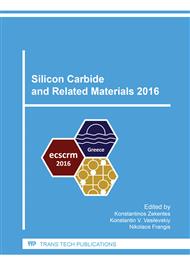p.279
p.283
p.287
p.291
p.295
p.299
p.303
p.307
p.311
Employing Scanning Spreading Resistance Microscopy (SSRM) for Improving TCAD Simulation Accuracy of Silicon Carbide
Abstract:
Computer-Aided-Design for the prediction of the technology process and the physical device properties (TCAD) is a key tool for the development and improvement of new device concepts as well as for the analysis and understanding of device properties and device behavior under application conditions. Apart from physical device models and parameters the precise process simulation of implanted doping profiles is mandatory for a sufficient prediction quality of the subsequent device simulations. In order to verify and improve the accuracy of process simulation, we employ the – for silicon carbide – relatively new method of Scanning Spreading Resistance Microscopy (SSRM) for the characterization of doping profiles.
Info:
Periodical:
Pages:
295-298
Citation:
Online since:
May 2017
Authors:
Keywords:
Price:
Сopyright:
© 2017 Trans Tech Publications Ltd. All Rights Reserved
Share:
Citation:


